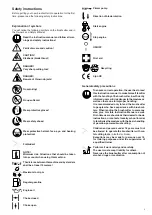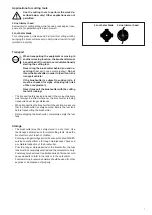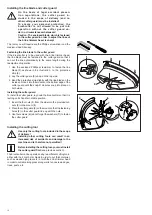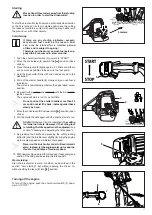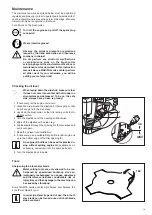
4
Personal protective equipment
• The clothing worn should be functional and appropriate, i.e.
it should be tight-fitting but not cause hindrance. Do not wear
either jewelry or clothing which could become entangled with
bushes or shrubs.
In order to avoid head-, eye-, hand- or foot injuries
as well as to protect your hearing, the following
protective equipment and protective clothing
must be used during operation of the brushcut-
ter.
• It is recommended to wear a protective helmet; it is imperative
when working in forests. The protective helmet (
1
) should be
checked at regular intervals for damage and must be replaced
after 5 years at the latest. Use only approved protective
helmets. If you have long hair, always wear a hairnet!
• The face shield (
2
) of the protective helmet protects against
flying sawdust, wood chips or stone chippings. During ope-
ration of the brushcutter always wear goggles or a visor to
prevent eye injuries.
• Wear adequate noise protection equipment to avoid hearing
impairment (ear muffs (
3
), ear plugs, etc.). Octave band
analysis upon request.
• The forestry safety jacket (
4
) is equipped with special red-
colored shoulder parts. The arms and neck should always
be protected by clothing.
• The protective trousers (
5
) are made from a nylon fabric with
22 layers and protects against cuts. We strongly recommend
its use. In any case, it is essential that a long pair of trousers
made of tough material be worn during operation of the
brushcutter. Do not wear short pants.
• Protective gloves (
6
) made of thick leather are part of the
prescribed equipment and must always be worn during
operation of the brushcutter.
• Safety shoes or boots (
7
) fitted with anti-skid sole, steel toe
caps and leg protection must always be used. Safety shoes
equipped with a protective layer give protection against cuts
and ensure a secure footing. Do not wear sandals or go
barefoot.
Handling fuels/refueling the brushcutter
Stop the engine and let the engine cool down
before refueling the brushcutter.
No smoking and no open flame!
Fuel may contain substances similar to solvents.
Eyes and skin should not come in contact with
mineral oil products. Always wear protective
gloves when refueling. Frequently clean and
change protective clothes. Do not breathe in fuel
vapors. Inhalation of fuel vapors can be hazardous
to your health.
• Before refueling the brushcutter make sure it is in a
stable
position.
• Do not spill fuel or oil. When you have spilt fuel or oil immedi-
ately clean the brushcutter. Fuel should not come in contact
with clothes. If your clothes come in contact with fuel, change
them at once.
• Ensure that no fuel oozes into the soil (environmental pro-
tection). Use an appropriate base.
• Refueling is not allowed in closed rooms. Fuel vapors will
accumulate near the floor (explosion hazard)!
• Carefully tighten the locking screw of the fuel tank and inspect
the fuel cap at regular intervals.
1
2
3
4
5
6
7



